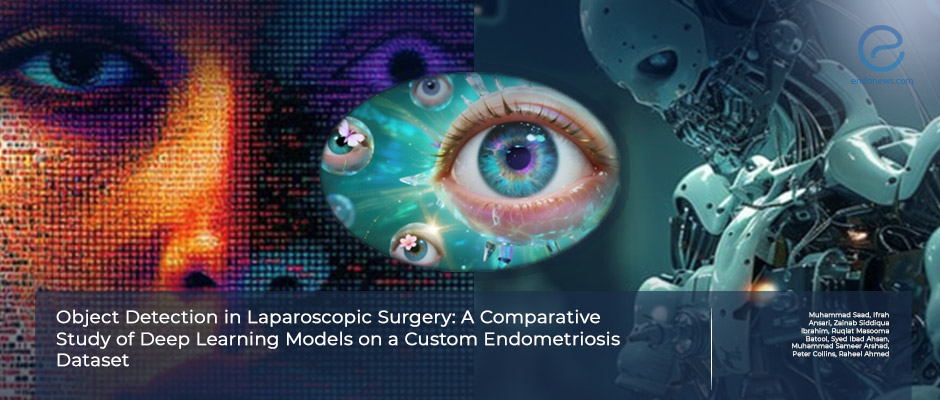Deep Learning Models for Object Detection in Laparoscopic Endometriosis Surgery
Aug 29, 2025
Artificial intelligence shows promise in guiding endometriosis surgery
Key Points
Importance:
- Endometriosis surgery requires precise lesion identification, yet visualization can be challenging, especially for small or atypical lesions.
- Artificial intelligence–based object detection has the potential to enhance laparoscopic accuracy, reduce missed lesions, and support surgical decision-making.
Highlights:
- Deep learning models can enhance laparoscopic endometriosis surgery by detecting lesions that may escape the human eye.
- This technology shows promise as a future surgical adjunct to improve completeness of excision and long-term patient outcomes.
What’s done here:
- Researchers developed a custom laparoscopic image dataset specific to endometriosis, annotated by experts to train and test deep learning models.
- Two state-of-the-art object detection algorithms were trained and validated for lesion detection:
- Faster R-CNN (designed for highly accurate object recognition)
- YOLOv9 (optimized for fast, real-time detection)
- Model performance was assessed using precision, recall, mean average precision, and F1 scores.
- Comparative evaluation determined which algorithm better suited the surgical environment.
Key Results:
- Faster R-CNN outperformed YOLOv9, achieving superior accuracy in detecting diverse endometriosis lesions.
- Deep learning was able to recognize subtle morphologies that can be overlooked during laparoscopy.
- Artificial intelligence -assisted detection could help reduce surgical blind spots and support more complete excision.
Strengths and Limitations:
- Being the first direct comparison of state-of-the-art deep learning models on a custom dataset specific to laparoscopic endometriosis; and to provide a foundation for integrating computer vision into real-time surgical workflows are the strengths of the study.
- Limitations are relatively small data size and drawn from a single setting; also, real-time application in live surgery has yet to be tested.
From the Editor-in-Chief – EndoNews
"Artificial intelligence has stepped into the operating room, and this study shows just how powerful that shift could be for endometriosis surgery. By applying deep learning to laparoscopic images, the authors demonstrate that Artificial Intelligence can reliably detect lesions—some of which might be subtle enough to evade the surgeon’s eye.
The clinical implications are striking. Incomplete excision is one of the major drivers of persistent pain and recurrence in endometriosis. IfArtificial Intelligence-assisted systems can highlight overlooked lesions in real time, surgeons could reduce blind spots, enhance precision, and potentially transform long-term outcomes. Importantly, the study found that models optimized for accuracy, rather than speed alone, performed best—a reminder that reliability must take precedence when lives are on the line.
For the field, this is more than a technical experiment: it signals a new era where digital intelligence could become a trusted surgical partner. While multicenter validation and live-surgery integration are needed, the trajectory is clear—Artificial Intelligence has the potential to reshape how we see, and how we treat, endometriosis."
Lay Summary
For endometriosis treatment, surgery remains the cornerstone, but its success depends heavily on the surgeon’s ability to detect and completely excise lesions.
Some endometriotic lesions can be subtle, hidden, or resemble surrounding tissue, which increases the risk of incomplete surgery and recurrence.
In a study recently published in Diagnostics, researchers explored whether artificial intelligence could support surgeons by improving lesion detection during laparoscopy. They developed a custom dataset of laparoscopic images of endometriosis, annotated by clinical experts, and trained two state-of-the-art deep learning models for object detection. The models compared were Faster R-CNN (a highly accurate image recognition system) and YOLOv9 (an algorithm designed for very fast, real-time detection).
The performance of both models was rigorously evaluated using statistical measures such as precision, recall, F1 score, and mean average precision. The results showed that Faster R-CNN outperformed YOLOv9, offering superior accuracy in identifying different types of endometriotic lesions. While YOLOv9 was faster, the study emphasized that accuracy is more critical than speed when guiding surgical decisions.
Beyond technical performance, the authors discussed the broader implications: artificial intelligence could serve as an “extra set of eyes” in the operating room, reducing surgical blind spots and supporting more complete excision. This could ultimately improve patient outcomes by lowering recurrence rates and minimizing repeat surgeries.

